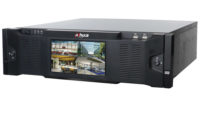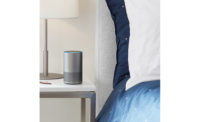Security cameras and recorders share a tight bond, with the past progression, current development and future innovation of each so closely intertwined that you could make the argument that they are simply extensions of one another. As manufacturers continue to increase the resolution and performance of cameras, they also ensure that recorders can not only keep pace but anticipate and be prepared for whatever the “next big thing” in cameras may happen to be.
With today’s recording solutions, as with their camera cousins, there are a number of technologies and trends that are shaping video surveillance, if not the security industry itself. For the security integrator, these developments — and those to come — can translate into opportunity, including potential RMR. From a business perspective alone, therefore, it’s a smart idea to keep up with what’s happening with the development of DVRs and NVRs.
“The top trends in the video recording space really represent the arc of the technology’s history, addressing both where the space has come from and where it’s moving,” says Peter Kim, senior director and head of global technical support for IDIS America, based in Coppell, Texas.
Here are the six biggest trends in DVRs and NVRs as identified by several industry insiders.
Efficiency
As demand grows for increasingly higher-resolution cameras, the expectation is that NVRs will be capable of supporting 4K resolution and beyond.
“As a matter of fact, 4K is quite popular at the current stage, so with the ever-increasing demand for high-definition, the market is in need of backend devices that can perfectly do the decoding work,” says Tim Chen, marketing director, Overseas Business Center for Dahua Technology, based in Hangzhou, China.
Looking ahead, the natural next step up in terms of compression is H.265, which is much more efficient than its predecessor, H.264, to reduce the potential strain 4K and others can place on bandwidth and storage requirements. As this standard emerges, recorders need to keep pace.
“NVRs will need to support better compression formats like H.265 to reduce bandwidth,” says Jammy DeSousa, product manager for Westborough, Mass.-based American Dynamics, part of Tyco Security Products. “H.265 will impact processing power required on the NVR and/or VMS to display or render higher-resolution video.”
The Cloud
As manufacturers continue to develop solutions that support improvements in throughput and storage capacity, the resulting technologies will enable more widespread use of cloud-based storage, says Ahmed Elsayed, sales engineer for City of Industry, Calif.-based Hikvision.
“Systems with back-end storage are still the norm, but cloud and edge storage may take the forefront in the future, rather than just serving as enhancements to the system,” he says. “With Internet bandwidth improvements, cloud storage will become more popular.” As SD card storage increases, performance improves, and prices decrease, utilizing them as a storage medium will become more popular as well.
NVRs and the VMS that runs on them play a significant role in enabling cloud-based storage, says Mark Espenschied, director of marketing, Digital Watchdog, Cerritos, Calif.
“With NVRs, we are talking about the continued development of the VMS for recording management and recording redundancy, as well as ‘trickling’ recording backup to the cloud to save longer timelines, and the ability to pull that video back to the NVR as needed,” he says.
Cloud-based storage can mean RMR for integrators, but it may not be the right solution for everyone, and it most likely won’t be anyone’s one and only recording solution, Espenschied says.
“The long term is small and enterprise solutions that rely more on the cloud to store video than on local storage,” he says. “For some applications, a minimal amount of local storage will be required.”
Mobility
Just look around and you can’t help but see the evidence of the very real need for “anytime, anywhere” connectivity. While some in the IT world cringed at the thought of what “bring your own device” (BYOD) would mean for networks, that model has become a reality. And as anyone knows, you can’t put the toothpaste back in the tube.
“The BYOD revolution has all but silenced the IT naysayers. Mobility is everywhere and it’s not going away,” DeSousa says. “We have seen mobility go from a check-box requirement to table-stakes for some of our largest customers. As the Millennial generation enters the workforce, this trend will only increase — and systems that don’t have mobility complements are in trouble.”
Mobile capability is an opportunity for integrators to generate the all-important RMR that will grow their profits and potentially increase the value of their company. Tyco Security Products and others have invested in their solutions to make sure integrators are armed with the functions their customers demand with full-featured mobile apps, Web clients and other technologies. Some manufacturers have extended their mobile offerings to include apps designed specifically to ensure smooth, efficient installation and service. (See “Service-Focused App” on page 100.)
Price Pressure
One not-so-pleasant development in the recording space is the downward price pressure that’s being driven by lower-cost equipment, which has led to DVRs and NVRs being treated almost as commodities, says Dan Cremins, director of product management, March Networks, Ottawa. However, he warns, there’s more that makes up a cost than simply purchase price.
“There’s a hidden cost that the purchase price doesn’t convey, based on functionality and stability, and that translates into less money for everyone,” Cremins says. “Today, people can buy a DIY system and get a 16-channel recorder with cameras for around $1,000. So it’s not just about the features, but what you’re really getting.”
Unless they’re built with solid-state technology, hard drives operate by spinning, which means they have moving parts. And moving parts fail eventually; it’s not if, but when they do. The fans used to cool the heat these drives generate add up to even more moving parts that will fail at some point. Cremins says this is just one example of the extra expense that can make low-cost recorders expensive in the long run.
“People should be aware of the hidden costs of recorders that may be low costs up front,” he says.
Unfortunately, he believes, selling against these seemingly low-cost solutions can be tricky.
“You can go through all of the features — many of which customers will never get to — but it all goes back to price,” he says. “The truth is these products are not built to last in the customer’s application. They may last a year or so, then someone has to roll a truck to replace them. That costs people a lot of money.”
And, he adds, it’s up to the integrator to make sure end users understand that the drive they’re buying today for a song could end up costing them an arm and a leg later on.
Video Verification
Driven by local and state mandates requiring alarms to be verified by video prior to law enforcement dispatch, video alarm verification (VAV) continues to impact the security industry. With the ability to reduce the time and costs associated with false alarms, video verification also allows law enforcement and emergency personnel to respond more quickly in the event of a fire, burglary or other emergency, says John Smith, senior product marketing manager, Honeywell, Melville, N.Y.
“The ability to see pre-alarm event footage lets monitoring personnel provide authorities with critical details and alert them to dangerous situations prior to dispatch,” he says.
Recorders can not only enable verification but can also increase the speed with which operators can perform this critical task. As such, integrators who can position these devices as such and can present end users with additional creative uses for their NVR will reap the benefits.
“Video alarm verification will give Integrators a great opportunity to add RMR, video device monitoring, video verification and guard tours to every surveillance proposal, sale and installation,” Smith says.
HD Over Coax
With HDcctv and other technologies that allow high-resolution video to be transmitted over coax technologies, end users are able to take advantage of high-quality video while extending the life of their existing analog infrastructure. This cost-effective approach is making HD accessible to a larger number of customers, Smith says.
“Customers are demanding higher-quality video at an economical price on smaller systems,” he says.
The opportunities these technologies present should be obvious. Integrators can offer their customers solutions that will future-proof their existing analog installations, and a number of NVRs ease the process of migrating to IP.
“Integrators can offer their customers HD-quality video at half the price of IP,” he says. “In addition, entry-level NVR solutions are making it easier for integrators to transition customers to IP at a lower price point. Prepackaged four-channel kits make it especially easy to purchase and install eight- and 16-channel NVRs, offering variety for larger requirements.”
Recognizing the need for flexibility and accommodating hybrid video systems, today’s NVRs and DVRs are being designed to allow integrators and end users to find the right mix of equipment for specific installations.
“The quest for optimal storage and quality — more important than ever as multi-megapixel cameras and the like take the stage — is, of course, the enduring trend in the video recording space. But the influence of legacy technologies is still highly relevant, as they continue to drive market demand for increased options and flexibility in complementing existing coaxial cable installations,” Kim says.
Therefore, Kim says, the modern NVR space must provide solutions that allow integrators to design systems that operate across different video formats and recording platforms.
“Not every camera in a system is equally important, and needs for storage redundancy vary, even within a system,” he says. “NVRs that maximize flexibility allow integrators to be at their smartest, finding the right mix and match for optimal efficiency and economy, which benefits all concerned, something that only works when the core technology and user interfaces are aligned, to provide the many tangible benefits of having the right NVR technology in the mix.”
In the security world, technology changes and systems grow to offer more and more features, functions and performance. With these advances come opportunities for integrators who take the time to familiarize themselves with what’s currently available and what may be coming in the near future. For those who have the right knowledge and the ability to think creatively about positioning DVR and NVR solutions, the potential to grow profits is very real.
SIDEBAR: The NVR Is in the Camera
Many camera models on the market today include some sort of recording capability, which can be used to complement traditional NVRs or DVRs. Or, as Digital Watchdog’s Mark Espenschied says, these all-in-one cameras could potentially replace standalone recording solutions altogether.
“IP integrators can provide a complete surveillance system to a small client by installing one or a few edge cameras without needing a network server for recording,” he says. “Using cameras with failover protection, integrators can provide fail-safe recording solutions where if a server goes down, after the fact the VMS can pull the uninterrupted recorded timeline from both the server and the camera.”
SIDEBAR: Service-Focused App
Integrators work with recorders from multiple manufacturers, making it difficult if not impossible to become experts in their entire product lines. Help can come in the form of online product manuals or phone support, but as Dan Cremins of March Networks says, both of those options take time.
Recognizing this, March Networks has created Guru, an app specifically for those who are in the field installing or servicing equipment. Based on the color and sequence of four LEDs on the front of a recorder, the app can identify problems and provide insight on how to correct them.
“They can just get out their phone and have access to all the information about the recorder,” he says. “They don’t have to go online or call someone at March Networks, making the installation more efficient, with less expense and cost. There’s also a QR code on the front of the box that they can scan and get the model, serial number and more.”
The app also provides advanced return materials authorization (RMA) to streamline the return process. By providing the means to identify and correct potential issues up front, March Networks hopes to save the time and expense of service later on.
“The integrators we spoke with said their biggest problem was the cost associated with rolling a truck, so we worked backward to figure out how we could help them,” Cremins says.
SIDEBAR: Integrated Solutions
ONVIF, PSIA and other standards have made significant headway in the industry in recent years. Where once the market was fragmented by the proliferation of proprietary technologies, today integrators and end users are able to mix and match equipment from different manufacturers to create systems that are best suited for specific installations. This trend toward openness will continue to blossom in the DVR and NVR space, says Hikvision’s Ahmed Elsayed.
“In line with the trend toward standardization in the market today, DVRs and NVRs will probably become more open source; they will support a wider range of camera manufacturers in the future,” he says. “Recorders will offer better integration options with VMS, access control, and POS, and accomplish all of the above at a lower cost.”
With this in mind, integrators can’t afford not to think openness when choosing recording solutions, particularly given the potential for these devices to interface with more and more security and non-security systems.
“Integrators should be sure to choose a recorder with an Open and Scalable platform. An open system with ONVIF standards will allow their customers to choose from a wider range of products to work with the recorder and to leverage any existing equipment they may already have installed,” Smith says. “If the system is also scalable, it can grow with them as their requirements change.”
While integrated systems have been a trend for quite some time, it’s altogether possible for the recording solution — combined with the VMS — to serve as the hub for this interconnectivity. For example, Smith says, Honeywell’s MAXPRO Cloud combines business intelligence with traditional security in one interface, while also integrating video and access control into a connected buildings solution.





